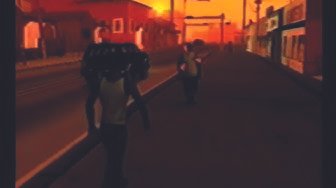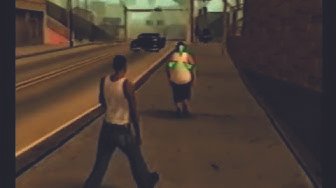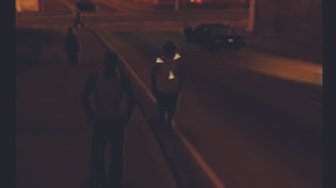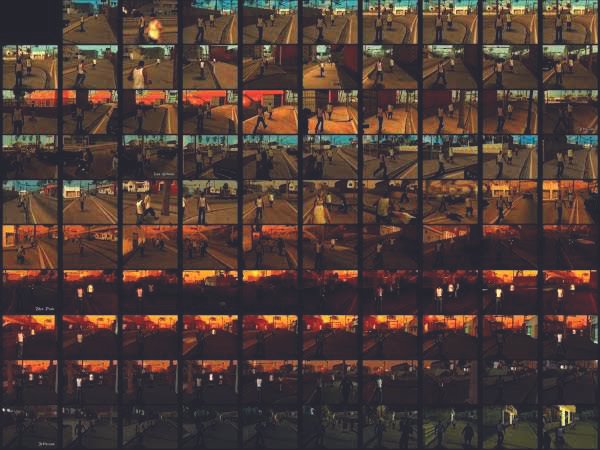I am a ghost watching my own body
We are player, viewer, voyeur, flaneur, spectator, and character all at once.
Image credit: Simon Harris
Anyone who has lived here for more than a day knows that once you cross west of the Red Rooster line, Sydney stops being a metropolis of the global imagination and becomes as vividly mundane as any other city. Sydney no longer exists as an air-conditioned nightmare of tourist wonders and shopping malls, instead becoming a place of complete silence. Just you and the silence of the train carriage. Just you and the silence of every other pedestrian on the street. Just you and the rest of the observable universe.
One of the first times I noticed this silence was when I first encountered Vito Acconci’s 1969 performance artwork, Following Piece. Searching it up will only show you an unspectacular bunch of photos and notes, but the actual performance is the most intriguing part of the artwork. The whole artwork documents Acconci as he follows passerbys on the street, pursuing them until that person either enters a building or until Acconci loses sight of them. The artwork itself is a violation of some of the most sacred contracts of art: the separation of art and audience, of artist and art. It obscures the borders dividing public and private space, questioning where the public commons end and where the boundaries of private (and personal) property begins. It transforms the pedestrian into an object of hostile spectatorship.
Vito Acconci, Following Piece (1969)
This distance between the self and the other which Acconci tries so desperately to cross, is the silence. The silence is the unwritten law that demands us to remain silent in the presence of strangers, and that refusal to do so is not only ‘disturbing the peace,’ but also a cause for shame, embarrassment, and loss of face. It is silence that fills the uneasy and unspoken company of people in rooms, lifts, trains, theatres, and classrooms. We live in regimes of silence, where we must hesitate before speaking, where we must consider and gauge the invisible, unspoken boundaries that define the self and the other even in the closest of proximities, even when skin touches skin in the clinical glow of offices or in the darkness of unnamed corridors. Where there is silence in the self, one must wordlessly follow the noise of the other.
In the Dictionary of Obscure Sorrows, the word ‘sonder’ refers to “the realisation that each random passerby is living a life as vivid and complex as your own.” Although it is a word I found while doomscrolling through Twitter one night, it is a feeling I have known my entire life. It is the acute realisation that we are creatures of narrative not only aching to be heard, but also aching for others to follow us in our life. It is a feeling that de-centres you, as the weightlessness of being the main character is all lost, and your life is buried by the stories of every other person around you. I think that beyond its investment into the art world, Following Piece (1969) is a work about sonder, of one person’s futile attempt to penetrate into the life of others.
If you search Following Piece on YouTube, you might be surprised to find out that it is also the title of another work of art. It doesn’t look like it, but these two videos of GTA: San Andreas gameplay by Aaron Taylor truly inherit the spirit of Vito Acconci’s performance nearly 4 decades prior. Viewers follow the protagonist, CJ, as he follows NPCs (non-player characters) around the city of San Andreas. He follows them almost brainlessly, as you and CJ bear witness to random outbursts of violence, provocations, and verbal abuse with utter indifference. The precariousness of Acconci’s performance is absent here, as we watch people shout, fight, and die from the safety of the screen. We fear Acconci’s performance because even in an age where mass surveillance is a norm, his form of spectatorship still feels criminal. Acconci demands us to confront our own complicity when we try to understand him and his artwork. It forces us to recognise the people we follow are real.
Aaron Taylor, Following Piece (2008)
But none of that exists in Taylor’s videos. The people CJ follow are pixelated and polygonical, designed by people you will never meet, voiced by actors whose names you don’t know of. They are no longer flesh but simply pixels on a screen. You are granted complete freedom with interactions: you can talk, approach, maim, and gift with whoever you please. We are player, viewer, voyeur, flaneur, spectator, and character all at once. You are free to follow others with impunity. To me, this is the most realistic and relatable part of the artwork.
Imagine walking along a random, peaceful street, only to look behind you and find that 195 people are chasing you down, their bodies descending upon you as you stumble in your escape, feeling their eyes following you. Now imagine that you are me, in the comfort of my bedroom, looking at the 195 follower count I have on Instagram. I don’t know most of these people. I only hang out with less than 10 close friends. We go to KFC on Thursdays and drive around the streets of Parramatta at night. But these 195 people follow me. They view my stories like people passing an aquarium, and I am but a fish, small and brainless in the prison of their screen. But I am really no more different than everyone else. A few days ago, my friend pointed out that I follow 1,676 accounts. One thousand! I check YouTube and it’s 971. TikTok, 611. Twitter, 161. Maybe this is just sonder, and I am simply Acconci and CJ, trying hopelessly to reconcile the distance between self and stranger. Maybe I have internalised the noise that is the internet and have forgotten that the regime of silence touches even our most private digital worlds. Maybe I am just another kid with their face glued to the glass, mindlessly watching the little fish breathe their little bubbles.
But I am neither the fish nor the child. I am the very aquarium itself. As I spent another night scrolling through TikTok, then Instagram Reels, then YouTube Shorts, it finally dawned on me that I am not actually watching other people. Every video consumed, every reel scrolled, every comment left, every short I have shared has fed this monster we call the algorithm with enough information to construct my digital profile and footprint. Everything I have ever seen and will ever see will only be refractions of myself. The screen has been made according to my image. It feels like I have lost my whole body somewhere in the infinitude of the internet and have been reduced to a pair of eyes, my gaze wandering deeper and deeper into the screen. I have become just another spectator of myself.
As I imagine Acconci stalking the streets of New York and watch CJ terrorise San Andreas, I accept that I am no longer the pedestrian, the audience, the voyeur, the spectator, the self or the other; I am only a ghost watching my own body.






